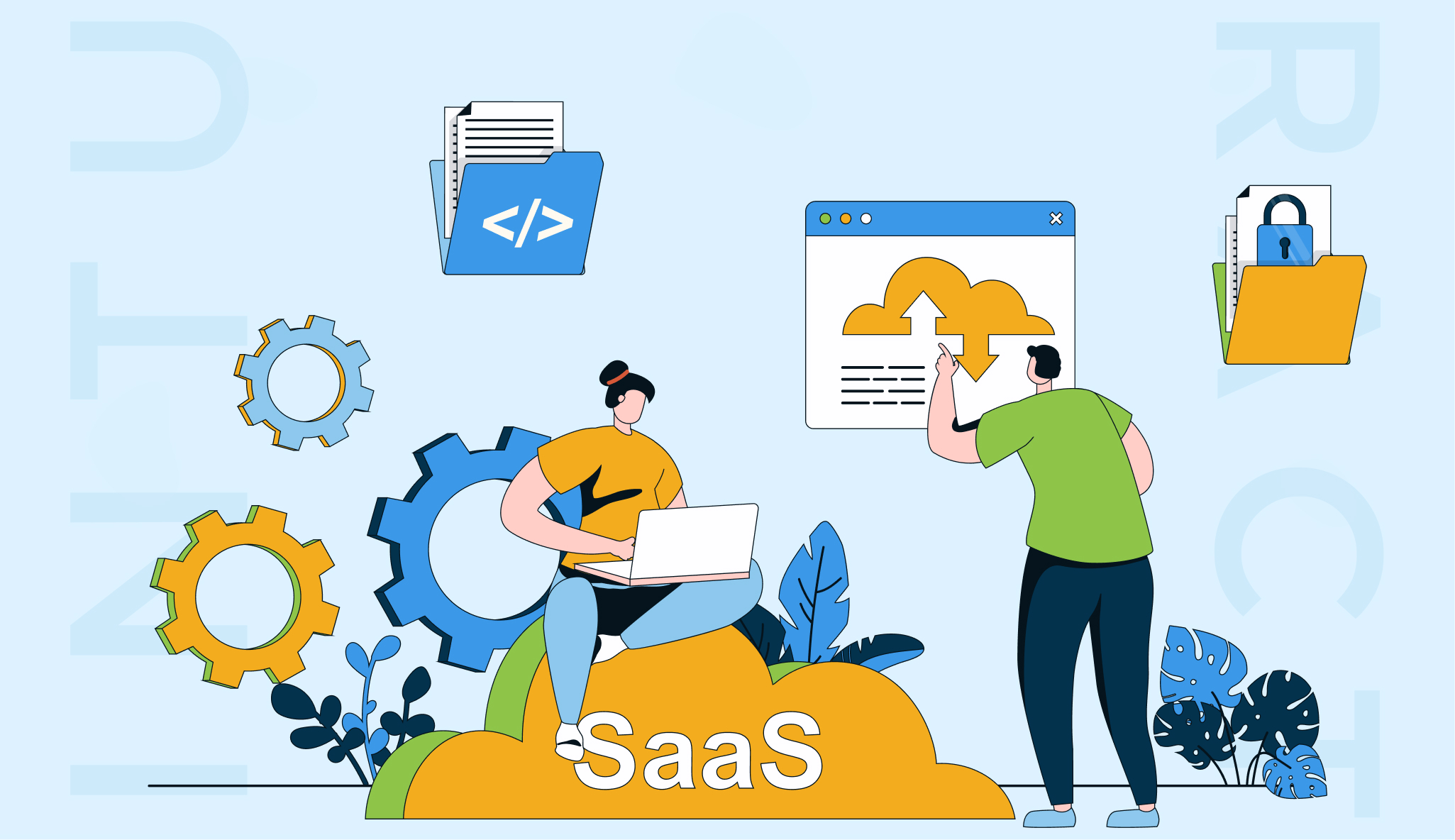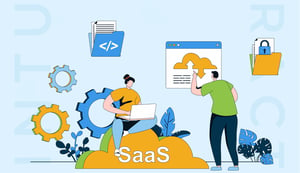
Making it in the SaaS industry takes not just an innovative product, but marketing savvy as well. In the sections that follow, learn what makes SaaS marketing different and what it takes to create a successful strategy to grow your business.
What is SaaS marketing?
When you’re running a SaaS business, you don’t do marketing the way other businesses do. It’s simply because the industry is so different from the traditional one. Among others, there are the issues of:
- Your product being intangible
- Your product being complex
- The industry being volatile
This is why SaaS marketing has fewer similarities than differences with regular marketing. SaaS businesses generally invest solely in digital marketing, often utilizing all the digital channels they have at their disposal. This means a lot of content marketing as opposed to traditional ads, such as print and TV.
Of course, there is one other important difference when it comes to SaaS businesses. It has to do with target audiences. Now, these can be either B2C or B2B, sometimes even both. This is exactly why it’s important to make sure the messaging is simple but explains all the benefits the product has to offer.
Although it’s not that easy to make a SaaS marketing strategy work, this type of business seems to be thriving. In 2018 only, SaaS businesses managed to generate a profit of around $72.2 billion. So how do you make sure you get a piece of the cake?
How does SaaS marketing work?
It’s good to know what separates SaaS from marketing in other industries. Still, this doesn’t answer the question of how SaaS marketing in particular works. Of course, there are some aspects to it that could be called universal for all types of marketing:
- Building awareness
- Generating leads
- Closing deals
But how do you really get leads and move them down your funnel? It’s a bit more complex than usual. The customer journey of a typical SaaS lead is not very straightforward and takes a lot longer to complete. That’s why in SaaS it’s all about customer retention.
As a result, to be successful in SaaS marketing, your strategy for keeping your customers happy even after they’ve become paying clients needs to be just as detailed and well thought out.
In the sections that follow, we’ll go into more detail on what a concrete SaaS marketing strategy can look like. For now, and before we go into tips and tricks to making yours successful, it might be helpful to know that this type of strategy usually includes producing a lot of content, optimizing that content for the search engines and doing both email and social marketing.
SaaS Marketing Tips to Help You Save Money
With SaaS products leading the way, recent research has confirmed that these applications are now at the forefront of steering the future of the software industry. How can you make your marketing budget work for you? There are some tips for saving your money.
First of all you should Invest in your customer service. Of course customer loyalty is based on a positive customer experience, after investing you should foster growth through cross-sells and up-sells. There are some tips you should know about saving money.
Here are 5 tips on how to make the most of your marketing budget.
1. Invest in your customer service
As consumers, we all know that brand loyalty is contingent upon a satisfying customer experience. After all, studies continue to emphasize that customer service has a direct impact on revenue. So few areas are as worthy of investment as developing customer success initiatives to protect new and existing customers. Most SaaS companies already have a wealth of SaaS marketing metrics at their fingertips that can easily be interpreted to pinpoint what elements of your customer service are working and which are better off left behind, preventing you from wasting time and resources on the wrong elements of your business.
Quite simply, a solid marketing plan is worthless without customer retention.
2. Foster growth through cross-sells and up-sells
Just as building your customer service efforts should play an integral role in your marketing plan, it’s important to remember that your best chance to boost revenue comes from your greatest asset: the customers themselves. As such, strategically positioned cross-sells and upsells may be key to expanding upon your client base. Although cross-selling can often entice customers to engage in related products, research shows that up-sells can be as much as 20 times more effective. Regardless, both methods are based on capitalizing on a proven provider-customer relationship, removing the far trickier task of winning the business of entirely new customers.
3. Maximize inbound marketing efforts
Content continues to be king when it comes to online promotion, with content marketing widely considered the most effective digital marketing tool. Using inbound marketing to lead potential customers straight to your product through blogs, social media, SEO and other content allows you to bring in leads who have already demonstrated an interest in your product and its application. Moreover, SaaS and inbound marketing are closely tied, since they both rely so heavily on a connection with customers’ immediate needs. With inbound marketing in place, these prospects can arrive at your product already ready to resolve these needs, making sales conversion that much easier.
4. Know your target market
While inbound marketing can help attract primed and ready customers to your product, this doesn’t discount the necessity to reach out to your target market directly. However, the trouble is that many times not enough forethought has gone into identifying which prospects are most likely to have a need for your product. As a result, resources can be wrongfully used to go after consumers with less interest in what your business has to offer. Take care in structuring your marketing effort so that you can be sure to maximize your chances at winning new business. A good place to start may be to develop a detailed profile for which groups may make up your ideal customer base.
5. Take advantage of retargeting for pay-per-click
The secret to tailoring your SaaS marketing campaign truly lies in identifying customers that are on the very brink of making a purchase decision and then stepping in with a quality product at just the right moment. Thanks to retargeting, you are able to reach out to potential customers who may have briefly expressed an interest in your product but who, for whatever reason, decided not to purchase at that moment. Retargeting ads give you the edge over your competition in that you can stay top-of-mind with interested consumers. In recent years, Google, Facebook and Twitter have all become hotbeds of retargeting activity, slowly winning over consumers. You can’t afford to miss out.
Want invaluable insight into how you should approach your SaaS products marketing budget? Check out our new eBook, “Understanding and Calculating Your SaaS Marketing Budget.”
<Keep the CTA from the old blog https://www.inturact.com/blog/saas-marketing-tips-that-will-save-you-money >
Tricks to get the best out of SaaS marketing
According to one study, in the first five years, the average SaaS business invests anywhere between 80 and 120 percent of the revenue in sales and marketing. Especially considering this, you definitely want to make the most out of all those resources. So what exactly can you do to make your SaaS marketing strategy a successful one?
Customer research
We’ve already said how important it is for SaaS businesses to retain their customers. This is why it’s vital to have a part of the strategy devoted solely to keeping them happy.
But it also means you should invest more in initial customer research. Of course, creating a quality buyer persona is important regardless of the industry you’re in. But other industries don’t rely as much on their customers wanting to keep buying their products for longer periods of time.
What does this mean exactly? It means that by doing poor customer research, you do your business a lot of harm. Closing deals with customers that won’t really be happy with your product puts you at risk of losing returning clients. To avoid this, you should make a note of customer pain points, starting by learning they prefer to communicate with businesses using local phone service or instant messaging.
Referral marketing
Whenever someone recommends your product, you’ve succeeded at raising awareness of your brand. It’s an achievement regardless of the industry you’re in. But it’s especially important in SaaS marketing.
Why is this so? It mostly has to do with the nature of both your product and industry. If you’re in SaaS, chances are you offer a product that’s helpful, but for it to be helpful, it needs to be complex. And there is a lot of competition out there, even if the businesses you’re competing against don’t solve your customers’ problems as well as you do.
So when someone refers to your product, it means you’ve succeeded at making people hear you above all that noise. And chances are that they won’t think as hard about whether you’re the right solution for them.
Engaging content
When you have a complex product, it becomes crucial to engage your potential customer from the moment they come in contact with you. If they’re not engaged, they won’t keep reading.
Of course, it could be said this is important regardless of the industry you’re in. But staying engaging means a lot more to a SaaS business than many others. After all, you need to be aware of the fact that it might take some time for your potential customer to figure out if you’re the right solution for their needs.
And the more engaging you are, the higher the chances that they won’t leave your site before they realize they want to do business with you.
This is exactly why a lot of SaaS businesses rely on the medium of webinars to attract customers. Webinars are engaging and informative at the same time. They give you the opportunity to present your business and product while giving your audience exactly what they need.
Customer testimonials
If you search for successful SaaS businesses online, you’ll find that there’s barely a website that doesn’t contain customer testimonials. It’s simply because it’s not that difficult to imagine someone buying a ring without checking any reviews. But committing to paying for a SaaS tool is a whole other thing, especially if the customer represents a business themselves.
This is exactly why a lot of SaaS businesses aim to gather testimonials even before the official product launch. Of course, to do this, you have to have some kind of strategy. The most common one relies on offering free trials. If your customers are happy, they will leave you a good review and you’ve already got some traction.
Supportive partnerships
To make your SaaS marketing strategy work, you don’t have to rely solely on your own resources. There’s always the option of partnering with another business to achieve your own goals.
Called channel sales, this model is based on using third parties to sell your own products. You develop a plan, give the partner all the necessary resources and motivate them by offering commission.
This may sound like a complicated strategy to enforce, especially if you’re only starting. And of course, it can be. But with the right tools, you can have your sales incentive program working for you in the background. The tools in question are software solutions that help you organize and automate the entire process, from onboarding the partner to keeping track of commissions.
Real-life examples of successful SaaS marketing
There are plenty of SaaS businesses that are worth looking into if you’re trying to develop a quality marketing strategy for yourself. Let’s take a look at Salesforce,
Salesforce
Top solution for website building and management, Salesforce has become a giant over the years with over $31 billion annual revenue. But what makes them so successful?
Of course, there are countless factors at play, but one of the most important ones would be engaging content marketing. Salesforce didn’t just tell their potential customers what they could get by using their product. They identified their biggest pain point - complicated and clunky software, and using their content, they declared war on it, literally.
Slack
Most companies’ collaboration tool of choice, Slack has taken the business world by storm. But what’s the secret behind its success?
It’s word of mouth, actually. Even before the launch, the founder took advantage of all his connections and got a lot of people to give his product a try. They then went on social media, mostly Twitter, to tell everyone how much they liked it. And that’s how Slack got thousands of subscribers on its very first day.
Shopify
If you’re selling online, that is, if you’re in the e-commerce business, chances are you’re using Shopify to manage your business. But how did this business manage to stand out from the crowd?
If we had to pick one thing, we’d say Shopify became so successful because of its outstanding customer service. It offered a level of communication and problem-solving that was unprecedented at the time. And by doing that, it made sure very few customers wanted to look for a better solution.
Conclusion
As you can see, SaaS marketing can be quite complex. But with the right insights and tools, you can significantly increase your chances of becoming one of the giants. After all, companies like Salesforce, Slack and Shopify had to start somewhere as well.



